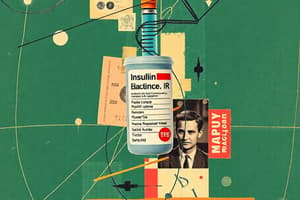Podcast
Questions and Answers
What is the therapeutic classification of regular (HumuLIN R)?
What is the therapeutic classification of regular (HumuLIN R)?
- Hormone (correct)
- Antidiabetic (correct)
- Analgesic
- Antibiotic
What are the main indications for using regular (HumuLIN R)?
What are the main indications for using regular (HumuLIN R)?
- Hypertension
- Hyperkalemia (correct)
- Hyperglycemia (DM) (correct)
- Dehydration
Regular (HumuLIN R) is classified as ____ acting.
Regular (HumuLIN R) is classified as ____ acting.
Rapid acting
What is the pregnancy category for regular (HumuLIN R)?
What is the pregnancy category for regular (HumuLIN R)?
What is the mechanism of action of regular (HumuLIN R)?
What is the mechanism of action of regular (HumuLIN R)?
What routes can regular (HumuLIN R) be administered via?
What routes can regular (HumuLIN R) be administered via?
The IV onset for regular (HumuLIN R) is ____ min.
The IV onset for regular (HumuLIN R) is ____ min.
How long is the peak duration for IV regular (HumuLIN R)?
How long is the peak duration for IV regular (HumuLIN R)?
How long does the action of IV regular (HumuLIN R) last?
How long does the action of IV regular (HumuLIN R) last?
The Subcutaneous onset for regular (HumuLIN R) is ____ min.
The Subcutaneous onset for regular (HumuLIN R) is ____ min.
How long is the peak duration for subcutaneous regular (HumuLIN R)?
How long is the peak duration for subcutaneous regular (HumuLIN R)?
The duration of action for subcutaneous regular (HumuLIN R) is ____ hours.
The duration of action for subcutaneous regular (HumuLIN R) is ____ hours.
What is a major contraindication for using regular (HumuLIN R)?
What is a major contraindication for using regular (HumuLIN R)?
What are some adverse reactions or side effects (ADR/SE) of regular (HumuLIN R)?
What are some adverse reactions or side effects (ADR/SE) of regular (HumuLIN R)?
What drug-drug interactions should be considered with regular (HumuLIN R)?
What drug-drug interactions should be considered with regular (HumuLIN R)?
What should be assessed when administering regular (HumuLIN R)?
What should be assessed when administering regular (HumuLIN R)?
What is a potential nursing diagnosis related to regular (HumuLIN R)?
What is a potential nursing diagnosis related to regular (HumuLIN R)?
What is an implementation strategy when using regular (HumuLIN R)?
What is an implementation strategy when using regular (HumuLIN R)?
What are key points in patient teaching for those using regular (HumuLIN R)?
What are key points in patient teaching for those using regular (HumuLIN R)?
What would indicate a positive evaluation outcome for a patient using regular (HumuLIN R)?
What would indicate a positive evaluation outcome for a patient using regular (HumuLIN R)?
Flashcards are hidden until you start studying
Study Notes
Therapeutic Classification
- Classified as an antidiabetic hormone.
Indications
- Used for treating hyperglycemia, particularly in diabetes mellitus (DM).
- Helpful in managing hyperkalemia.
Action
- Functions as a rapid-acting insulin.
Pregnancy Category
- Classified as Category B, indicating no proven risk to the fetus in humans.
Mechanism of Action
- Lowers blood glucose levels by stimulating glucose uptake in tissues.
- Inhibits glucose production in the liver.
Routes of Administration
- Administered via intravenous (IV) or subcutaneous (sub-q) routes.
IV Onset-Peak-Duration
- Onset: 30 minutes after administration
- Peak effect: 15 to 30 minutes
- Duration: 30 to 60 minutes
Sub-q Onset-Peak-Duration
- Onset: 30 to 60 minutes
- Peak effect: 2 to 4 hours
- Duration: 5 to 7 hours
Contraindications
- Not to be used in patients with hypoglycemia.
Adverse Reactions/Side Effects
- Potentially life-threatening reactions include anaphylaxis and hypoglycemia.
- Other side effects may involve lipodystrophy at injection sites.
Drug-Drug Interactions
- Beta blockers and clonidine may mask hypoglycemia signs.
- Corticosteroids, thyroid supplements, and estrogen can increase insulin requirements.
- Alcohol, ACE inhibitors, oral hypoglycemics, and salicylates may decrease insulin requirements.
Assessment
- Monitor signs and symptoms of hypo- and hyperglycemia.
- Assess blood glucose levels and A1C results regularly.
Potential Nursing Diagnosis
- Altered nutritional metabolism related to decreased endogenous insulin production, evidenced by serum blood glucose levels above 250 mg/dL.
Implementation
- Classified as a high-alert medication; requires careful handling.
- Use insulin syringes for administration.
- When mixing insulins, always draw regular insulin first.
- Rotate injection sites to prevent lipodystrophy.
- For IV administration, decrease infusion rate when blood sugar reaches 250 mg/dL and utilize an IV pump for safety.
Patient Teaching
- Instruct on self-administration techniques for insulin.
- Emphasize that insulin control is for managing DM, not curing it.
- Teach blood sugar testing techniques and interpreting results.
- Discuss dietary considerations for diabetes management.
- Inform about signs and symptoms of hypo- and hyperglycemia and outline treatment steps.
- Advise on when to contact healthcare providers for concerns.
Evaluation
- A positive outcome is indicated by achieving normal blood glucose levels and A1C results.
Studying That Suits You
Use AI to generate personalized quizzes and flashcards to suit your learning preferences.



